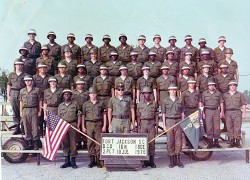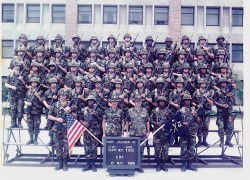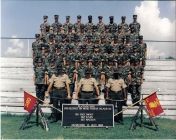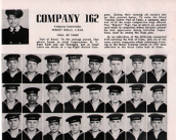A Field Artillery Surveyor is a member of the Army's Field Artillery Team. Field Artillery Surveyors are responsible for ensuring the Army's Field Artillery weapon systems are emplaced with exact precision enabling the Field Artillery weapon systems to deliver accurate and lethal firepower.
13S1O - Skill Level One




FA Surveyor / Vehicle Driver: Records field data, prepares schematic sketches and marks survey stations. Performs astronomic observation, measures azimuths, angles and determines deviations for target, connection and position area surveys with angular measuring equipment. Assist PADS/IPADS operator with the transfer, strap down and preparation for operations of PADS/IPADS. Compute data using logarithms or calculator to obtain the unknown required field data to include computing for accuracy ratios and adjustment. Operates and performs PMCS on vehicles, radios, weapons, and all survey equipment.
13S2O - Skill Level Two

PADS Team Chief: Supervises and coordinates PADS/IPADS vehicle operations. Computes survey data, plots geographic/UTM grid coordinates and performs azimuth transfer with PADS/IPADS. Operates PADS/IPADS system, performs calibrations, zero velocity updates, and PMCS on PADS/IPADS system. Assist collection, evaluation, and dissemination of survey information. Provide leadership and technical guidance to lower grade personnel.
13S3O - Skill Level Three

Chief Surveyor: Selects and determines survey starting data and reviews data for errors. Supervises the proper maintenance on all assigned section equipment, prepares technical, personnel, and administrative reports covering training objectives and survey operations. Orients, instructs, and leads surveyors in survey procedures and techniques to include PADS/IPADS operations. Provides leadership and technical guidance to lower grade personnel. Determines methods of survey in order to obtain required accuracy, participates, prepares, organizes, and schedules the survey parties. Serves as the principal assistant to the survey officer and performs his duties in his absence. Provides leadership, expertise, and inspects section equipment and vehicles to ensure the proper application of PMCS. Develops training plan to accomplish the training objective. Direct collection, evaluation, and dissemination of field artillery survey information. Coordinates survey operations with other units and maintains survey maps/overlays.
13S4O - Skill Level Four

Chief Surveyor: Selects and determines survey starting data and reviews data for errors. Supervises the proper maintenance on all assigned section equipment, prepares technical, personnel, and administrative reports covering training objectives and survey operations. Orients, instructs, and leads surveyors in survey procedures and techniques to include PADS/IPADS operations. Provides leadership and technical guidance to lower grade personnel. Determines methods of survey in order to obtain required accuracy, participates, prepares, organizes, and schedules the survey parties. Serves as the principal assistant to the survey officer and performs his duties in his absence. Provides leadership, expertise, and inspects section equipment and vehicles to ensure the proper application of PMCS. Develops training plan to accomplish the training objective. Direct collection, evaluation, and dissemination of field artillery survey information. Coordinates survey operations with other units and maintains survey maps/overlays.
Platoon Sergeant: The platoon sergeant is the primary assistant and advisor to the platoon leader with the responsibility of training and caring for soldiers. The platoon sergeant helps the commander to train the platoon leader and in that regard has an enormous effect on how that young officer perceives NCOs for the rest of his career. The platoon sergeant takes charge of the platoon in the absence of the platoon leader. As the lowest level senior NCO involved in the battery METL, platoon sergeants teach collective and individual tasks to soldiers in their sections or equivalent small units. A platoon sergeant or sergeant first class generally has extensive military experience and can make accurate decisions in the best interest of the mission and the soldier. Utilizing tough, realistic and intellectually and physically challenging performance-oriented training to excite and motivate soldiers, the platoon sergeant ensures Army standards are met and maintained. Additionally, the platoon sergeant must conduct cross training to promote critical wartime skills within the unit, evaluate the effectiveness of the platoon and provide training feedback to the commander and first sergeant during After-Action Reviews (AAR) on all unit collective training.
Platoon Sergeant: The platoon sergeant is the primary assistant and advisor to the platoon leader with the responsibility of training and caring for soldiers. The platoon sergeant helps the commander to train the platoon leader and in that regard has an enormous effect on how that young officer perceives NCOs for the rest of his career. The platoon sergeant takes charge of the platoon in the absence of the platoon leader. As the lowest level senior NCO involved in the battery METL, platoon sergeants teach collective and individual tasks to soldiers in their sections or equivalent small units. A platoon sergeant or sergeant first class generally has extensive military experience and can make accurate decisions in the best interest of the mission and the soldier. Utilizing tough, realistic and intellectually and physically challenging performance-oriented training to excite and motivate soldiers, the platoon sergeant ensures Army standards are met and maintained. Additionally, the platoon sergeant must conduct cross training to promote critical wartime skills within the unit, evaluate the effectiveness of the platoon and provide training feedback to the commander and first sergeant during After-Action Reviews (AAR) on all unit collective training.
School Information


Field Artillery Center/School, Fort Sill, OK
School: 061 School Location: FT SILL, OK
Course Title: FIELD ARTILLERY SURVEYOR
FY: 2009 School: 061 Course: 412-13S10 Phase: Course Length: 7 Weeks 0.0 Days
Verifiable Prerequisites Prerequiste Item Value(s) or Range Constraint PULHES 211211 Required
Normal Red/Green (RG) Perception YES Required
Physical Demand Rating VERY HEAVY - LIFT OCCASIONAL OVER 100 LB, FREQUENT 50 LB Required
Course Security Clearance Y - NONE Required
ASVAB ST Score 091 Required
Prerequisite Courses
There are no Prerequisite Courses.
Text Prerequisites
Active Army/USMC and reserve component enlisted personnel.
Qualifying scores.
(a) A minimum score of 95 in aptitude area ST in Armed Services Vocational Aptitude Battery (ASVAB) tests administered prior to 2 Jaunuary 2002.
(b) A minimum score of 92 in aptitude area ST on ASVAB tests administered on and after 2 January 2002 and prior to 1 July 2004.
(c) A minimum score of 91 in aptitude area ST on ASVAB tests administered on and after 1 July 2004.
Course Scope:
Skills that a level one personnel need to perform as a member of a field artillery survey party are: tactical communications, map reading, determine the distance between stations by mechanical and electronic means, determine direction by astronmic observation and gyroscopic means, operate angular measuring instruments and automated survey systems, record field data,
prepare schematic sketches of field surveys, and finally compute direction, distance, grid coordinates, height and astronomic azimuth from field data
Special Information:
There is no Special Information.
School: 061 School Location: FT SILL, OK
Course Title: FIELD ARTILLERY SURVEYOR
FY: 2009 School: 061 Course: 412-13S10 Phase: Course Length: 7 Weeks 0.0 Days
Verifiable Prerequisites Prerequiste Item Value(s) or Range Constraint PULHES 211211 Required
Normal Red/Green (RG) Perception YES Required
Physical Demand Rating VERY HEAVY - LIFT OCCASIONAL OVER 100 LB, FREQUENT 50 LB Required
Course Security Clearance Y - NONE Required
ASVAB ST Score 091 Required
Prerequisite Courses
There are no Prerequisite Courses.
Text Prerequisites
Active Army/USMC and reserve component enlisted personnel.
Qualifying scores.
(a) A minimum score of 95 in aptitude area ST in Armed Services Vocational Aptitude Battery (ASVAB) tests administered prior to 2 Jaunuary 2002.
(b) A minimum score of 92 in aptitude area ST on ASVAB tests administered on and after 2 January 2002 and prior to 1 July 2004.
(c) A minimum score of 91 in aptitude area ST on ASVAB tests administered on and after 1 July 2004.
Course Scope:
Skills that a level one personnel need to perform as a member of a field artillery survey party are: tactical communications, map reading, determine the distance between stations by mechanical and electronic means, determine direction by astronmic observation and gyroscopic means, operate angular measuring instruments and automated survey systems, record field data,
prepare schematic sketches of field surveys, and finally compute direction, distance, grid coordinates, height and astronomic azimuth from field data
Special Information:
There is no Special Information.




